About 60km south of the center of Hanoi , Trach Xa Ao Dai craft village, located in Hoa Lam commune, Ung Hoa district, Hanoi, is known as one of the places where the traditional Ao Dai sewing profession of Vietnam originated.
With a history of more than 1,000 years, this village is not only famous for its exquisitely beautiful ao dai, exuding the craftsmanship and talent of the craftsmen, but also contains extremely valuable intangible cultural values. This is not only the pride of the local people but also a valuable heritage, contributing to the preservation and promotion of national cultural identity through each generation.
History of the craft village
Trach Xa village has long been famous for its traditional ao dai tailoring craft, which has been passed down and preserved through many generations. The children of the village have brought with them the quintessence of the profession when migrating to many other localities, contributing to the glory of the ao dai tailoring craft through famous brands. In particular, the long-standing ao dai tailoring shops on Luong Van Can and Cau Go streets in Hanoi are living proof of that spread.
The pride of Trach Xa people is Mrs. Nguyen Thi Sen, the founder of the village's tailoring profession, who was once the fourth concubine of King Dinh Tien Hoang. She was known as a talented, skillful and creative woman. She was the one who designed the splendid costumes for the emperor, concubines and members of the royal family at that time.
Not only that, she also devoted herself to teaching the sewing profession to the palace maids, helping to develop the industry in the royal palace and thereby laying the foundation for the formation of the traditional ao dai sewing profession.
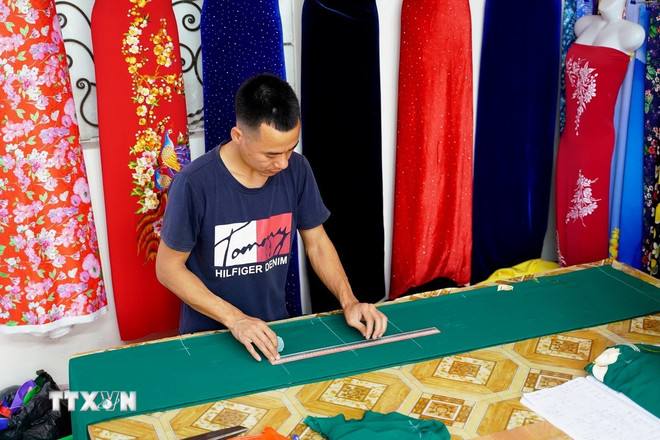
In 979, after a major incident occurred in the Dinh Dynasty court, Lady Tu Phi Nguyen Thi Sen decided to take her children away from the royal palace and return to her hometown of Trach Xa.
Here, she devoted herself to teaching the craft of tailoring to the villagers. Since then, tailoring has gradually become a unique feature, passed down from father to son, generation after generation thanks to the dedication of the Trach Xa people to preserve and develop it. This has helped tailoring rise from a personal skill to a valuable traditional craft of this land.
Every year, December 12 is chosen as the anniversary of the Vietnamese sewing profession, which is the death anniversary of Lady Tu Phi Nguyen Thi Sen. On this occasion, descendants from all over the country, along with large and small companies and sewing factories, eagerly return to the homeland of the profession to pay tribute and commemorate her founding merits. The atmosphere of the anniversary is extremely solemn and imbued with traditional culture, showing respect for the person who laid the foundation for the development of the sewing industry in Vietnam.
Besides the death anniversary, January 4th also has a special meaning in Trach Xa village tradition, considered the day of opening needles and pulling - a milestone marking the beginning of a new year full of hope in the tailoring profession. On this day, villagers gather together at the sacred space of the Ancestor Temple, offering solemn offerings to ancestors and gods.
In particular, competitions demonstrating craftsmanship are also held to honor those with outstanding talent in the tailoring profession, while also reinforcing pride in long-standing traditional values.
What is special about Trach Xa Ao Dai craft village?
Trach Xa craft village stands out with its unique features that have existed since ancient times, when the number of men working in the tailoring profession was greater than that of women due to local traditions, where women were only allowed to assist men in their work. However, with the change in social concepts, the role of women has gradually been equalized, allowing them to work in tailoring professions equivalent to men.
The sewing style of Trach Xa villagers stands out with a very different and unique vertical needle holding technique, creating a distinct feature. Instead of letting the needle move as usual, this technique requires the needle to stand still, while the fabric continuously moves, skillfully matching each stitch.
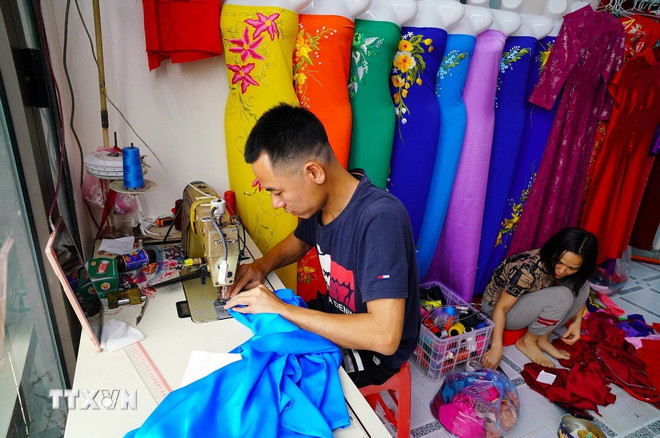
The Trach Xa villagers perform the needle-holding operation with such skill that it feels like they are holding nothing in their hands. When sewing, the index finger of the right hand plays the role of firmly holding the needle, while the middle finger of the right hand creates precise force to push the needle. At the same time, the fingers of the left hand are responsible for adjusting and orienting the fabric, helping the fabric surface move up and down rhythmically and flexibly with each stitch. This delicate technique not only requires dexterity but also demonstrates the long-standing traditional secret of the craftsmen here.
After completion, the product has a flat inner edge as if glued, while the outer surface has neat, even, and delicate stitches like spider silk threads. Therefore, "glue inside, spider eggs outside" has become an indispensable standard for tailors in Trach Xa. Another characteristic that contributes to affirming the name of this craft village is not using industrial thread but taking advantage of silk threads taken from the silk fabric used to sew the ao dai.
If industrial threads are used during the washing process, the body of the dress will easily shrink due to the effects of heat and water, making the ao dai stiff and lose its flexibility. On the contrary, Trach Xa ao dai has the outstanding feature of not shrinking after washing, maintaining its natural look and inherent softness. By using silk threads taken directly from the fabric used to make the dress, the dress achieves uniformity in material, ensuring that the dress always retains its graceful appearance, without becoming stiff or stretched. Nowadays, despite the appearance of industrial sewing machines, the role of the machine only accounts for a very small part of the process. Sewing machines are mainly used to support hidden seams inside, while exposed seams must be done entirely by hand to ensure aesthetics and sophistication.
In addition to making ao dai, ceremonial dresses and statue dresses, Trach Xa village also produces blankets, pillows, cotton shirts, costumes for the film industry and exports diverse products to the Korean and Mongolian markets, affirming its position in both traditional and international fields.
Trach Xa craft village not only preserves traditional values but also becomes a solid symbol of long-standing cultural beauty. At the end of April 2024, this traditional sewing village was officially recognized as one of 26 National Intangible Cultural Heritages, affirming its important role in preserving and promoting national identity.
Trach Xa village's traditional tailoring profession still maintains its core values thanks to the manual methods and the ingenuity of talented artisans. The people here not only work hard but also wholeheartedly teach tailoring to the younger generation, ensuring that the passion for Vietnamese ao dai will be maintained forever. Festivals honoring the ao dai tailoring profession also take place regularly, creating a special attraction and attracting a large number of tourists from all over.
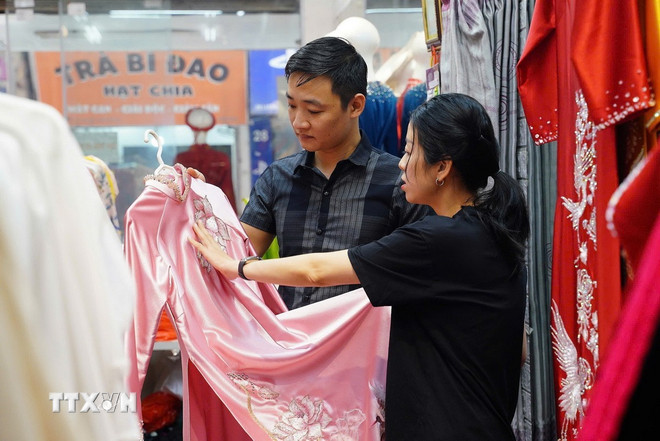
When arriving at Trach Xa, visitors not only witness the meticulous process of creating beautiful ao dai but also have the opportunity to directly experience the tailoring process. Under the dedicated guidance of the artisans, you will feel more deeply the ingenuity and sophistication behind each stitch.
In addition, you can order Ao Dai right in the village with many diverse designs, from traditional to modern innovations. Tailored to your liking, these Ao Dai are not only meaningful gifts but also a living embodiment of Vietnamese culture, helping to leave an indelible mark in the hearts of every visitor./.
Source: https://www.vietnamplus.vn/lang-nghe-ao-dai-trach-xa-chua-dung-gia-tri-van-hoa-phi-vat-the-vo-cung-quy-gia-post1024408.vnp


![[Photo] More than 17,000 candidates participate in the 2025 SPT Competency Assessment Test of Hanoi National University of Education](https://vphoto.vietnam.vn/thumb/1200x675/vietnam/resource/IMAGE/2025/5/17/e538d9a1636c407cbb211b314e6303fd)
![[Photo] Prime Minister Pham Minh Chinh chairs meeting on science and technology development](https://vphoto.vietnam.vn/thumb/1200x675/vietnam/resource/IMAGE/2025/5/17/ae80dd74c384439789b12013c738a045)


![[Photo] Readers line up to visit the photo exhibition and receive a special publication commemorating the 135th birthday of President Ho Chi Minh at Nhan Dan Newspaper](https://vphoto.vietnam.vn/thumb/1200x675/vietnam/resource/IMAGE/2025/5/17/85b3197fc6bd43e6a9ee4db15101005b)















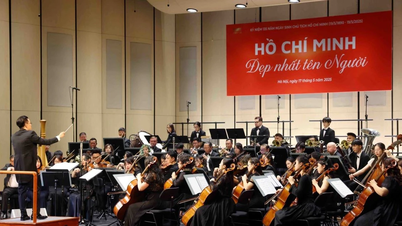



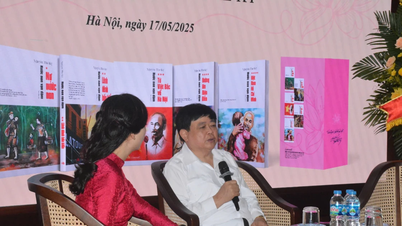

![[Photo] Nearly 3,000 students moved by stories about soldiers](https://vphoto.vietnam.vn/thumb/1200x675/vietnam/resource/IMAGE/2025/5/17/21da57c8241e42438b423eaa37215e0e)




















































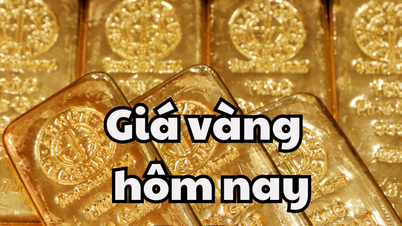
















Comment (0)